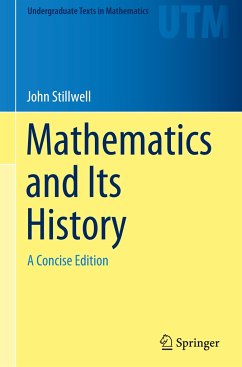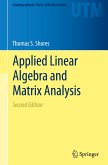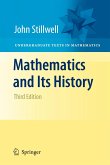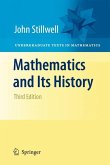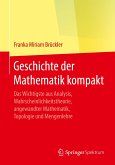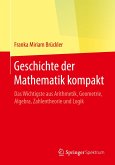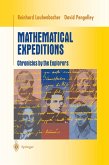This textbook provides a unified and concise exploration of undergraduate mathematics by approaching the subject through its history. Readers will discover the rich tapestry of ideas behind familiar topics from the undergraduate curriculum, such as calculus, algebra, topology, and more. Featuring historical episodes ranging from the Ancient Greeks to Fermat and Descartes, this volume offers a glimpse into the broader context in which these ideas developed, revealing unexpected connections that make this ideal for a senior capstone course.
The presentation of previous versions has been refined by omitting the less mainstream topics and inserting new connecting material, allowing instructors to cover the book in a one-semester course. This condensed edition prioritizes succinctness and cohesiveness, and there is a greater emphasis on visual clarity, featuring full color images and high quality 3D models. As in previous editions, a wide array of mathematical topics are covered, from geometry to computation; however, biographical sketches have been omitted.
Mathematics and Its History: A Concise Edition is an essential resource for courses or reading programs on the history of mathematics. Knowledge of basic calculus, algebra, geometry, topology, and set theory is assumed.
From reviews of previous editions:
"Mathematics and Its History is a joy to read. The writing is clear, concise and inviting. The style is very different from a traditional text. I found myself picking it up to read at the expense of my usual late evening thriller or detective novel.... The author has done a wonderful job of tying together the dominant themes of undergraduate mathematics." Richard J. Wilders, MAA, on the Third Edition
"The book...is presented in a lively style without unnecessary detail. It is very stimulating and will be appreciated not only by students. Much attention is paid to problems and tothe development of mathematics before the end of the nineteenth century.... This book brings to the non-specialist interested in mathematics many interesting results. It can be recommended for seminars and will be enjoyed by the broad mathematical community." European Mathematical Society, on the Second Edition
The presentation of previous versions has been refined by omitting the less mainstream topics and inserting new connecting material, allowing instructors to cover the book in a one-semester course. This condensed edition prioritizes succinctness and cohesiveness, and there is a greater emphasis on visual clarity, featuring full color images and high quality 3D models. As in previous editions, a wide array of mathematical topics are covered, from geometry to computation; however, biographical sketches have been omitted.
Mathematics and Its History: A Concise Edition is an essential resource for courses or reading programs on the history of mathematics. Knowledge of basic calculus, algebra, geometry, topology, and set theory is assumed.
From reviews of previous editions:
"Mathematics and Its History is a joy to read. The writing is clear, concise and inviting. The style is very different from a traditional text. I found myself picking it up to read at the expense of my usual late evening thriller or detective novel.... The author has done a wonderful job of tying together the dominant themes of undergraduate mathematics." Richard J. Wilders, MAA, on the Third Edition
"The book...is presented in a lively style without unnecessary detail. It is very stimulating and will be appreciated not only by students. Much attention is paid to problems and tothe development of mathematics before the end of the nineteenth century.... This book brings to the non-specialist interested in mathematics many interesting results. It can be recommended for seminars and will be enjoyed by the broad mathematical community." European Mathematical Society, on the Second Edition
"This is a beautiful book. ... it would be fun to teach a course from it and I hope to get that chance. ... This book flows so well that I did not feel anything was lacking from it. ... I am confident that the many readers of Stillwell's work will find it satisfying and worthwhile to update their libraries with this edition. Those currently unfamiliar with his work will find this a delightful place to begin." (Michele Intermont, MAA Reviews, October 18, 2021)
"Mathematics and Its History is an original, engaging and effective book, which I think would be enjoyed by students, lay readers with the right background, or indeed mathematicians themselves." (Danny Yee, Danny Yee's Book Reviews, dannyreviews.com, March, 2019)
From the reviews of the third edition:
"The author's goal for Mathematics and its History is to provide a "bird's-eye view of undergraduate mathematics." (p. vii) In that regard it succeeds admirably. ... Mathematics and its History is a joy to read. The writing is clear, concise and inviting. The style is very different from a traditional text. ... The author has done a wonderful job of tying together the dominant themes of undergraduate mathematics. ... While Stillwell does a wonderful job of tying together seemingly unrelated areas of mathematics, it is possible to read each chapter independently. I would recommend this fine book for anyone who has an interest in the history of mathematics. For those who teach mathematics, it provides lots of information which could easily be used to enrich an opening lecture in most any undergraduate course. It would be an ideal gift for a department's outstanding major or for the math club president. Pick it up at your peril - it is hard to put down!"
(Richard Wilders, MAA Reviews)
"I appreciate and recommend Stillwell's presentation of mathematics and history written in a lively style. The author's concept (history mostly as the means of approaching mathematics) remains a matter of interest for both the mathematician and the historian ... ." (Rüdiger Thiele, Zentralblatt MATH, Vol. 1207, 2011)
From the reviews of the second edition:
"This book covers many interesting topics not usually covered in a present day undergraduate course, as well as certain basic topics such as the development of the calculus and the solution of polynomial equations. The fact that the topics areintroduced in their historical contexts will enable students to better appreciate and understand the mathematical ideas involved...If one constructs a list of topics central to a history course, then they would closely resemble those chosen here."
(David Parrott, Australian Mathematical Society)
"The book...is presented in a lively style without unnecessary detail. It is very stimulating and will be appreciated not only by students. Much attention is paid to problems and to the development of mathematics before the end of the nineteenth century... This book brings to the non-specialist interested in mathematics many interesting results. It can be recommended for seminars and will be enjoyed by the broad mathematical community."
(European Mathematical Society)
"Since Stillwell treats many topics, most mathematicians will learn a lot from this book as well as they will find pleasant and rather clear expositions of custom materials. The book is accessible to students that have already experienced calculus, algebra and geometry and will give them a good account of how the different branches of mathematics interact."
(Denis Bonheure, Bulletin of the Belgian Society)
From the reviews of the third edition:
"The author's goal for Mathematics and its History is to provide a "bird's-eye view of undergraduate mathematics." (p. vii) In that regard it succeeds admirably. ... Mathematics and its History is a joy to read. The writing is clear, concise and inviting. The style is very different from a traditional text. ... The author has done a wonderful job of tying together the dominant themes of undergraduate mathematics. ... While Stillwell does a wonderful job of tying together seemingly unrelated areas of mathematics, it is possible to read each chapter independently. I would recommend this fine book for anyone who has an interest in the history of mathematics. For those who teach mathematics, it provides lots of information which could easily be used to enrich an opening lecture in most any undergraduate course. It would be an ideal gift for a department's outstanding major or for the math club president. Pick it up at your peril - it is hard to put down!"
(Richard Wilders, MAA Reviews)
"I appreciate and recommend Stillwell's presentation of mathematics and history written in a lively style. The author's concept (history mostly as the means of approaching mathematics) remains a matter of interest for both the mathematician and the historian ... ." (Rüdiger Thiele, Zentralblatt MATH, Vol. 1207, 2011)
From the reviews of the second edition:
"This book covers many interesting topics not usually covered in a present day undergraduate course, as well as certain basic topics such as the development of the calculus and the solution of polynomial equations. The fact that the topics areintroduced in their historical contexts will enable students to better appreciate and understand the mathematical ideas involved...If one constructs a list of topics central to a history course, then they would closely resemble those chosen here."
(David Parrott, Australian Mathematical Society)
"The book...is presented in a lively style without unnecessary detail. It is very stimulating and will be appreciated not only by students. Much attention is paid to problems and to the development of mathematics before the end of the nineteenth century... This book brings to the non-specialist interested in mathematics many interesting results. It can be recommended for seminars and will be enjoyed by the broad mathematical community."
(European Mathematical Society)
"Since Stillwell treats many topics, most mathematicians will learn a lot from this book as well as they will find pleasant and rather clear expositions of custom materials. The book is accessible to students that have already experienced calculus, algebra and geometry and will give them a good account of how the different branches of mathematics interact."
(Denis Bonheure, Bulletin of the Belgian Society)

